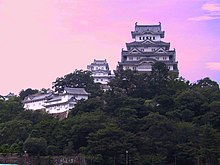Himeji Castle: Difference between revisions
Adding geodata: {{coor title dms|34|50|22|N|134|41|38|E|region:JP_type:landmark}} |
|||
| Line 8: | Line 8: | ||
==Architecture, defenses, and design== |
==Architecture, defenses, and design== |
||
[[Image:Himejijou_castle_grounds.jpg|thumb|500px|none|A panoramic view of the castle grounds, with Himeji city in the background]] |
[[Image:Himejijou_castle_grounds.jpg|thumb|500px|none|center|A panoramic view of the castle grounds, with Himeji city in the background]] |
||
Himeji serves as an excellent example of the prototypical [[Japanese castle]], containing many of the defensive and architectural features most associated with Japanese castles. The tall stone foundations, whitewash walls, and organization of the buildings within the complex are standard elements of any Japanese castle, and the site also features many other examples of typical castle design, including gun emplacements and stone-dropping holes. The current keep dates from [[1601]]. |
Himeji serves as an excellent example of the prototypical [[Japanese castle]], containing many of the defensive and architectural features most associated with Japanese castles. The tall stone foundations, whitewash walls, and organization of the buildings within the complex are standard elements of any Japanese castle, and the site also features many other examples of typical castle design, including gun emplacements and stone-dropping holes. The current keep dates from [[1601]]. |
||
Revision as of 16:47, 7 January 2007

Coordinates: 34° 50' 22"N, 134° 41' 39"E
Himeji Castle (Template:Lang-ja; -jō) is a Japanese castle located in Himeji in Hyogo Prefecture. It is one of the oldest surviving structures from medieval Japan, and was registered as the first Japanese National Cultural Treasure by UNESCO World Heritage Site and a Japanese National Cultural Treasure in December, 1993. Along with Matsumoto Castle and Kumamoto Castle, it is one of Japan's "Three Famous Castles", and is the most visited castle in Japan. It is occasionally known as Hakurojō or Shirasagijō ("White Heron Castle") because of its brilliant white exterior.
Himeji Castle frequently appears on Japanese television. Edo Castle (the present Kokyo) does not have a keep, so when a fictional show such as Abarenbo Shogun needs a magnificent substitute, the producers turn to Himeji.
Architecture, defenses, and design

Himeji serves as an excellent example of the prototypical Japanese castle, containing many of the defensive and architectural features most associated with Japanese castles. The tall stone foundations, whitewash walls, and organization of the buildings within the complex are standard elements of any Japanese castle, and the site also features many other examples of typical castle design, including gun emplacements and stone-dropping holes. The current keep dates from 1601.
One of Himeji's most important defensive elements, and perhaps its most famous, is the confusing maze of paths leading to the main keep. The gates, baileys, and outer walls of the complex are organized so as to force an approaching force to travel in a spiral pattern around the castle on their way into the keep, facing many dead ends. This allowed the intruders to be watched and fired upon from the keep during their entire approach. However, Himeji was never attacked in this manner, and so the system remains untested.
History


The castle was conceived and constructed during the Nanboku-cho era of the Muromachi period. At this time, it was called Himeyama Castle. In 1346, Akamatsu Sadanori planned a castle at the base of Mount Himeji, where Akamatsu Norimura had constructed the temple of Shomyoji. After Akamatsu fell during the Kakitsu War, Yamana clan briefly took over planning of the castle; the Akamatsu family took over again following the Ōnin War.
In 1580, Toyotomi Hideyoshi took control of the castle, and Kuroda Yoshitaka built a three-story tower.
Following the Battle of Sekigahara in 1601, Tokugawa Ieyasu granted Himeji Castle to Ikeda Terumasa. Ikeda embarked on an eight-year expansion project that brought the castle roughly to its current form. The last major addition, the Western Circle, was completed in 1618.
Himeji was one of the last holdouts of the tozama daimyō at the end of the Edo period. It was held by the descendants of Sakai Tadasumi until the Meiji Restoration. In 1868, the new Japanese government sent the Okayama army, under the command of a descendant of Ikeda Terumasa, to shell the castle with blank cartridges and drive its occupiers out.
When the han system was abolished in 1871, Himeji Castle was sold at auction. Its final price was 23 yen and 50 sen. However, the cost of dismantling the castle proved to be prohibitive, and as a result it was abandoned.
The Tenth Infantry Regiment occupied Himeji Castle in 1874, and the War Ministry took control of the castle in 1879. The main tower was renovated in 1910 using 90,000 yen in public funds.
Himeji was bombed in 1945, at the end of World War II. Although most of the surrounding area was burned to the ground, the castle survived almost entirely unscathed.
Restoration
Castle restoration efforts began in 1956 after several aborted attempts.[1] The process used only traditional construction equipment and methods, and was completed in 1964.
Popular culture
In film
- James Bond film You Only Live Twice starring Sean Connery 1967, Himeji Castle appears as Tiger Tanaka's secret ninja training school and rocket weapons development center.
- Akira Kurosawa's 'Ran' 1985, Himeji was used for large parts of the film,
- The Last Samurai 2003 starring Tom Cruise, shot on location at Himeji Castle using artificial snow
- Shogun'''70s starring Richard Chamberlain, shot on location at Himeji Castle although calling it Osaka Castle - and you can't really see it from the water
External links
- Himeji Castle Guide
- Himeji castle website (requires Macromedia Flash plugin)
- Official UNESCO page for Himeji castle
- Himeji Tourist Information・Worlds Cultural Heritege Himeji castle

